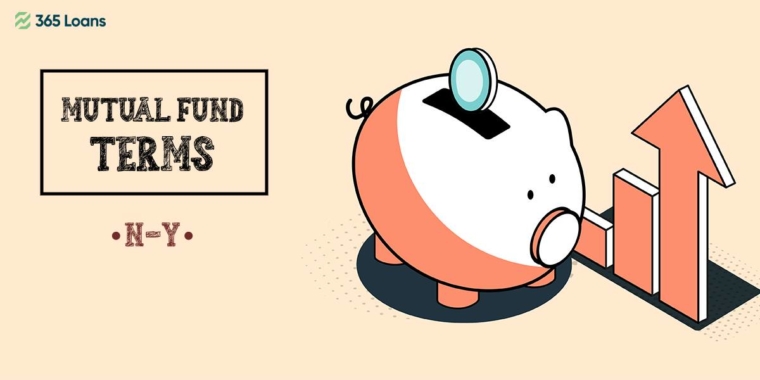Take a look at our list of 111 widespread mutual fund terms starting with any letter from A to Y, including numbers, that will enrich your investment vocabulary and help you not to fall out of context.
– # –
12b-1 Fees – Fees deducted from the assets of a mutual fund or an exchange-traded fund to pay the costs of promoting and selling mutual fund shares and providing shareholder services. Shareholder Service Payments are fees paid to those who answer investor questions and give information about their investments. Examples of distribution fees are fees used to compensate brokers and others who sell fund shares and pay for advertising, prospectus printing and sending to new investors, and sales brochure production and mailing.

– A –
Absolute Return – Measures a fund’s performance over any two points in time, over any given time frame. However, because it ignores the effect of time, this method of computing returns is faulty.
Account Fee – A fee charged by some mutual funds to investors who want to keep their accounts separate. Accounts with balances below a specified dollar amount, for example, may be subject to an account charge.
Advisor (or Adviser) – An individual or an organization that manages assets or gives investment advice. A financial adviser, investment advisor, or investment counsel is another name for a financial advisor.
Advisory Fee – A fee paid to the managers of a mutual fund for their services; typically covers fund administration and investor communications.
Alerts – A notification you receive (by phone, post, or e-mail) when you specify a sell objective on a plan and the mutual fund reaches that target.
AUM (Assets Under Management) – The total market value of the investments (assets) that an asset management company operates on behalf of its investors.
AMC (Asset Management Company) – The Mutual Fund’s Investment Manager administering the pool of investor money on behalf of the investors. All purchases and sales of securities in the portfolio of the Mutual Fund’s various Mutual Fund schemes are handled by an AMC.
Asset Allocation – The categorization of investments into cash, income, and growth buckets to optimize the risk-reward balance; based on investment needs.
Authorized Participants – Financial institutions, often large broker-dealers, that ETFs form contractual arrangements with to acquire and redeem creation units of ETF shares.
Average Maturity Period – The average of the securities specified maturity dates in a debt fund’s portfolio. The longer the debt fund’s maturity time, the more susceptible it is to interest rate changes, reflected in more considerable volatility.
– B –
Back-End Load – See Exit Load.
Basis Point – One-hundredth of 1 percent (0.01 percent). Basis points are frequently used to simplify decimal percentages. For example, one percent is equal to 100 basis points.
Benchmark – A norm, usually an unmanaged index, that is used to compare the performance of a portfolio or mutual fund.
Brokers – A middleman between a buyer and a seller, usually in exchange for a commission.
Brokerage Commissions – The fund pays a charge to its brokers for each purchase or sale of mutual fund securities.
– C –
Capital Gain – The difference between the selling price of an object and its initial acquisition price.
Capital Loss – A drop in the value of an asset or an investment. A capital loss is the polar opposite of capital gain.
Classes – Class A shares, Class B shares, and others are different types of shares issued by the same mutual fund. Each class has the same investment objectives and policies and invests in the same securities pool (or an investment portfolio). However, each type includes unique shareholder services or distribution arrangements and additional fees and expenses, resulting in distinct performance outcomes.
Closed-End Fund – A closed-end investment company, is a type of investment company that does not continuously offer its shares for sale. Instead, it sells a fixed number of shares at a time (in an initial public offering), which then trade on a secondary market, such as the New York Stock Exchange or the Nasdaq Stock Market.
CDSC (Contingent Deferred Sales Charge) – A back-end load whose size is determined by how long an investor has held mutual fund shares. For example, if an investor owns their shares for one year, the contingent delayed sales load can be (X) percent, (X-1) percent after two years, and annually reducing until the shipment reaches zero and entirely disappears.
Conversion – Some mutual funds have a feature that allows investors to switch from one class to another (usually with lower yearly charges) after a defined time. If a class converts to another type, it will be stated in the mutual fund’s prospectus or summary prospectus.
Corpus – The quantity of money accessible to invest in a scheme. The corpus is the current worth of the scheme’s portfolio if it has already been invested.
Cost Averaging – A strategy for lowering the average cost price of a security by buying more of it when its price declines. For example, it’s a tactic utilized by systematic investment programs in mutual funds.
Coupon Payments – Annual interest paid on a bond from when it is issued until it matures. Coupons are frequently reinvested at current interest rates, and upon maturity, the cumulative interest is paid along with the initial principle investment. The coupon rate is calculated by dividing the number of coupons delivered each year by the bond’s face value.
Credit Risk – The risk a lender faces that the borrower may fail to keep its promise of revenue in the future. In any transaction, there are two parties, one of whom owes the other money. There is a contractual agreement between the two parties when the price is not immediate but is expected to occur. The borrower is expected to pay back the loan at some point in the future. Because the lender is the counterparty, there is a risk that the borrower will not be able to repay the loan or pay the periodic future interest payments for various reasons.
Creation Units – Large blocks of shares, typically sold in in-kind exchanges to Authorized Participants.
– D –
Debt Funds – The class of schemes that invest only in debt securities to generate a steady income while preserving capital. Debt funds are divided into three categories based on the type and mix of debt instruments they invest in: income funds, gilt funds, and liquid funds.
Default Risk – Refers to the likelihood of a borrower failing to meet their financial commitments under a contract. For example, we say a consumer has defaulted on his payment responsibilities if he fails to make a monthly payment of equated monthly installments (EMIs) on a home loan from a bank.
Deferred Sales Charge – See Back-End Load.
Discount to NAV – When the market price of an ETF is less than the value of its underlying holdings.
Distribution Fees – Fees paid out of the mutual fund or ETF assets to cover expenses for marketing and selling mutual fund or ETF shares. This includes compensation for brokers, advertising costs, and payments for printing and mailing prospectuses and sales literature. Sometimes referred to as 12b-1 Fees.
Dividend Reinvest Option – Within a Mutual Fund scheme, there are three options to grow your money – growth, dividend reinvesting, and dividend payout. In the case of dividend reinvestment, you can reinvest the dividend made by the scheme during the intermediate period back into the scheme.
Dividend Payout – Within the dividend payout option, you receive any profit (surplus) declared by the scheme when you remain invested. You can then either accept the payouts or reinvest the declared dividend back into the scheme. The dividend payout option provides a regular cash flow, though there is no guarantee that the scheme will continue to pay you dividends always at regular intervals.
Dividend Stripping – Buying a stock before the declaration of dividends and selling it off once the dividend is declared to save taxes by showing a capital loss on the sale transaction.

– E –
Exchange Fee – If shareholders trade (transfer) to another mutual fund within the same fund group, some mutual funds levy a fee.
ETF (Exchange-Traded Funds) – ETFs are a type of investment company that differs from traditional mutual funds in that their shares trade on the secondary market and are only redeemable by Authorized Participants from the fund itself in large blocks (for example, blocks of 50,000 shares) called creation units.
Ex-Dividend Date – The day the scheme’s NAV falls by the same amount as the dividend or capital gain delivered to investors.
Exit Load – Charges for redemptions or cancellations made within a specific time frame. Exit load acts as a deterrent to investors selling their Mutual Fund investments too soon, similar to a penalty for early redemptions.
Expense Ratio – А mutual fund’s or ETF’s total annual operating expenses (including management fees, distribution (12b-1) fees, and other costs) expressed as a percentage of average net assets.
– F –
Forward Pricing – A term used to indicate the price at which mutual fund shareholders can purchase or sell their shares in the fund. Following the fund’s receipt of a shareholder transaction order, shareholders must receive the next computed share price.
Front-End Load – Investors pay an upfront sales price, often known as an entry load when they buy mutual fund shares, used by the mutual fund to compensate brokers. A front-end load reduces the amount available to purchase fund shares.
FMP (Fixed Maturity Plans) – Short-term debt funds with a defined maturity date. To reduce the interest rate risk, such schemes invest in debt instruments that mature simultaneously as the scheme.
Fund Fact Sheet – A newsletter that examines the performance of all the company’s schemes over the reference period, provides essential scheme information such as portfolio details, and provides predictions for the future.
Fund House – See Asset Management Company (AMC).
Fund of Funds – A form of mutual fund that invests mainly in shares of other mutual funds rather than individual stocks.
– G –
Gilt Funds – A type of debt fund that invests in government securities and treasury bills to generate consistent returns while assuming a low risk.
G-secs – Short form for government securities that the government issues to finance its fiscal deficit. G-secs with less than one year of maturity are called T-bills or Treasury bills. Then, those with more than one year of maturity are referred to as Government bonds. G-secs are a government’s debt obligation that promises to pay investors the initial invested amount or principal at maturity and a fixed or floating interest rate at periodic intervals.
Growth Option – Оne of the options to grow your money with Mutual Funds. A growth option focuses on the long-term growth of capital. In the case of the growth option, you choose not to opt for dividends. A growth plan is suitable for those looking to grow their worth over the long term and who don’t look forward to intermediate payouts from the fund.
– H –
Hybrid Fund – А mutual fund that simultaneously invests in equity and fixed-income securities, which can change proportionally over time or remain fixed.
– I –
Income Funds – A debt fund primarily investing in corporate bonds and government securities, which have extended maturities. For the medium to long term, an income fund seeks to maximize debt returns.
Indexation – The method of adjusting the purchase price of assets such as gold, real estate, and debt mutual funds to account for inflation when computing returns on these investments.
Index Fund or ETF – A mutual fund or exchange-traded fund whose investing goal is to match the performance of a market index, such as the S&P 500 Composite Stock Price Index, the Russell 2000 Index, or the Wilshire 5000 Total Market Index.
Interest Rate Risk – Bond prices and interest rates have an inverse connection. Bonds’ attractiveness is determined by the interest rate available on bonds with similar risk profiles, as bonds are issued with the guarantee of a fixed coupon or interest rate. When interest rates rise, bond prices fall, and when interest rates fall, bond prices rise. Interest rate risk refers to the fluctuation in bond prices caused by interest rate changes. The most significant risk connected with debt investments is interest rate risk. Interest rate risk is a risk that a bond investor confronts since the value of their bond may fluctuate due to interest rate changes.
Investment Adviser – See Advisor.
Investment Objective – An overview of the financial goal that a Mutual Fund scheme aspires to attain and the level of risk that it is expected to take in the process. The investment aim of the plan aids investors in determining whether the scheme is appropriate for their portfolio. In brief, a scheme’s investment aim attracts like-minded investors who have comparable risk and time horizon choices and share a shared investment goal.
Investment Company – A company that issues securities and primarily invests in securities. The three primary investment companies are open-end funds (mutual funds and most ETFs), closed-end funds, and unit investment trusts (some ETFs).
– L –
Level Load – When shares are sold within the first year after purchase, funds levy an annual 12b-1 fee and a contingent deferred sales charge.
Lifecycle Fund – See Target Date Fund.
Lifestyle Funds – Mutual funds that maintain a predetermined risk level and include adjectives like “conservative,” “moderate,” or “aggressive” in their names to signify the fund’s risk level, also known as target risk funds.
Liquidity – The ability to have immediate access to money that has been invested. Mutual funds are liquid, for their shares can be redeemed on any business day for the next computed net asset value (NAV).
Liquid Funds – A short-term debt investment strategy that includes treasury bills, commercial paper, and the call money market. Its goal is to protect the principal while providing an average return and a high level of liquidity.
Load – See Sales Charge.
Load-Adjusted Return – The Return on a mutual fund is adjusted downward to reflect any sales fees, whether front-end or back-end.
Load Fund – A mutual fund that charges a sales charge (front-end load), a contingent deferred sales load (CDSC), or a fund that levies a 12b-1 fee greater than 0.25 percent.
Long-Term Funds – A term used in the mutual fund industry to describe all mutual funds other than money market funds. Equity (stock), bond, and hybrid funds are the three types of long-term funds.
Lock-In Period – The period when investors cannot withdraw investments made in a scheme. A lock-in period of three years applies to equity-linked savings schemes in mutual funds.
– M –
Management Fee – Any other management fee payable to the fund’s investment adviser or its affiliates and any administrative fee payable to the investment adviser that is not included in the “Other Expenses” category are all costs paid out of the mutual fund or ETF assets for managing the fund’s portfolio.
Market Index – A metric for assessing the performance of a given basket of stocks or bonds that represents a specific market or sector of the US stock market or economy. The Dow Jones Industrial Average (DJIA) is an index of 30 blue chip industrial firms in the United States (excluding transportation and utility companies).
Money Market Fund – A mutual fund that invests in short-term, high-quality, fixed-income securities and seeks the highest income level consistent with capital preservation (e.g., maintaining a stable share price).
Mutual Fund – An open-end investing company’s famous name. Like other investment firms, mutual funds aggregate money from many participants and invest it in short-term money market instruments, stocks, bonds, and other securities. Rather than buying from investors on the secondary market, mutual funds issue redeemable shares that investors acquire directly from the fund (or through a fund broker).
Mutual Fund Units – Represent the extent of ownership you have in the Mutual Fund as an investor and are like shares of a company that trades in the market. It is the currency of a mutual fund.

– N –
NAV (Net Asset Value) – The asset value minus the liability value of a mutual fund or ETF per share. SEC guidelines require mutual funds and ETFs to compute the NAV daily. Therefore, a fund’s NAV per share is calculated by subtracting its liabilities from its assets and dividing the result by the number of outstanding shares.
No-Load Fund – A mutual fund that does not charge any sales load. But not every type of shareholder fee is a sales load, and a no-load fund may charge fees that are not sales loads. No-load funds also charge operating expenses.
NFO (New Fund Offer) – NFO is Mutual Fund’s attempt to establish a new scheme with a starting and an ending date. For a maximum of 15 days, NFOs are available for subscription.
– O –
Offer Document – See Prospectus.
Open-End Company – The legal name for a mutual fund and most ETFs. An open-end company is a type of investment company.
Operating Expenses – The costs incurred by a mutual fund or ETF in connection with running the fund, including management fees, distribution (12b-1) fees, and other expenses.
– P –
PIN (Personal Identification Number) – An identification number given by a mutual fund to its unit holders to enable self-service transactions such as buying and selling units over the Internet and checking an account statement on the fund’s website.
Pooled Investing – The basic concept behind mutual funds and other investment companies is that a fund aggregates investors’ assets who share common financial goals. A fund uses the pooled assets to buy a portfolio of investments, and each share purchased represents a shareholder’s pro rata ownership interest in the fund’s portfolio.
Portfolio – Combined bonds, stocks, or other securities and assets holdings.
Premium to NAV – When an ETF’s market price is trading higher than the value of the underlying holdings.
Principal Underwriter – A mutual fund underwriter enters into sales agreements with retail distributors (e.g., broker-dealers) of the mutual fund. To sell fund shares, a retail distributor must have executed a contract with a fund or its principal underwriter, which authorizes the distributor to offer and sell fund shares to the public. Generally speaking, a fund’s underwriter is not involved in providing or selling fund shares to investors.
Prospectus – A document that describes a mutual fund or an exchange-traded fund (ETF). The prospectus details the costs, investment objectives, risks, and fund performance. A prospectus is available from the mutual fund or ETF sponsor (through its website, phone, or mail).
Purchase Fee – Some mutual funds charge a shareholder fee when investors purchase mutual fund shares. Not the same as a Front-End Load.
Redemption Fee – When investors redeem (or sell) mutual fund shares within a specific time frame after obtaining them, certain mutual funds levy a shareholder fee. Back-end loads are not the same as redemption fees (which must be paid to the fund). The Securities and Exchange Commission (SEC) sets a ceiling of 2% for redemption costs.
– R –
Record Date – The date when a scheme’s books are closed to finalize the list of unit holders entitled to receive the benefits such as dividends, rights, and bonuses. Only unit holders whose names are there on the record date will receive the stated use.
Redemption or Repurchase – When a unit holder sells units back to the mutual fund.
Reinvestment – The process by which investors in equity or fixed-income securities reinvest the intermediate disbursements they receive from their investment. Examples include dividends, interest or coupon payments, capital gains, bonuses, and others, to buy more units of the same asset, whether a stock, bond or other security.
Repurchase Price – The price at which a unit holder sells their shares back to a mutual fund. The repurchase price is usually the NAV minus an exit load.
Returns – The return on an investment expressed as a percentage. Changes in NAV are used to calculate returns in mutual funds.
RTA (Registrar and Transfer Agents) – The entity appointed by a mutual fund to serve its investors.
– S –
Sales Charge – The amount investors pay when they purchase (entry load) or redeem (exit load) shares in a mutual fund, similar to a brokerage commission.
Secondary Market – Where existing securities are bought and sold.
Shareholder Fees – Fees charged directly to investors in connection with particular investor transactions such as buying, selling, or exchanging shares or periodically concerning account fees, including sales loads, purchase, or redemption fees.
Shareholder Service Fees – Fees paid out of the mutual fund or ETF assets to persons to respond to investor inquiries and provide investors with information about their investments. See also 12b-1 Fees.
Short-Term Fund – See Money Market Fund.
SAI (Statement of Additional Information) – A disclosure document that provides information about a mutual fund or ETF in addition to, and sometimes in more detail, than the prospectus. Although mutual funds and ETFs are not required to provide investors with the SAI, they must give investors the SAI upon request and without charge.
SIP (Systematic Investment Plan) – A service option, allowing investors to buy mutual fund shares regularly, usually through bank account deductions.
Summary Prospectus – A disclosure document summarizing essential information for mutual funds and ETFs.
Switching – Shifting your investments from one Mutual Fund scheme to another within the same Mutual Fund.
STP (Systematic Transfer Plan) – On a specific day each month, you can transfer a fixed number of units or an amount from your investment in one Mutual Fund plan to another managed by the same fund institution. STP is a risk management method in which you switch your assets from an equity fund to a debt fund or vice versa, based on your market view.
SWP (Systematic Withdrawal Plan) – A payment plan that allows you to withdraw predetermined sums from your investments at regular intervals, similar to a scheme.
– T –
Target Date Fund – A fund designed to satisfy its investors’ investment objective by a particular target date, usually included in the fund’s name. For example, a Target Date 2025 fund may be designed for persons planning to retire in 2025.
Total Annual Fund Operating Expense – All annual fund operating expenses of a mutual fund or exchange-traded fund, represented as a percentage of the fund’s average net assets. The fee table in the prospectus includes the total yearly fund running expenses.
Triggers – A helpful feature that allows you to set investment targets for mutual funds. The fund house will automatically redeem your units and send you a check when this goal is met. Triggers are commonly based on value or time.
Trustee – Internal regulators in a mutual fund whose job is to ensure that the fund house is safeguarding the interests of the unit holders.
– U –
UIT (Unit Investment Trust) – A form of an investment firm that usually makes a single public offering of a limited number of units. When a UIT is created, it is set to end and dissolve on a specific date. UITs do not trade their investment portfolios regularly.
Unit – See Mutual Fund Units.
Unit Holder – A person or entity who holds units in a scheme.
– Y –
YTM (Yield-to-Maturity) – The estimated total Return or rate of interest that an investor would earn if they held a bond to maturity and reinvested all bond cash flows (principal repayment at maturity and coupon payments) at this rate. The bond’s Yield-To-Maturity is the interest rate at which all cash flows are considered to be reinvested.







